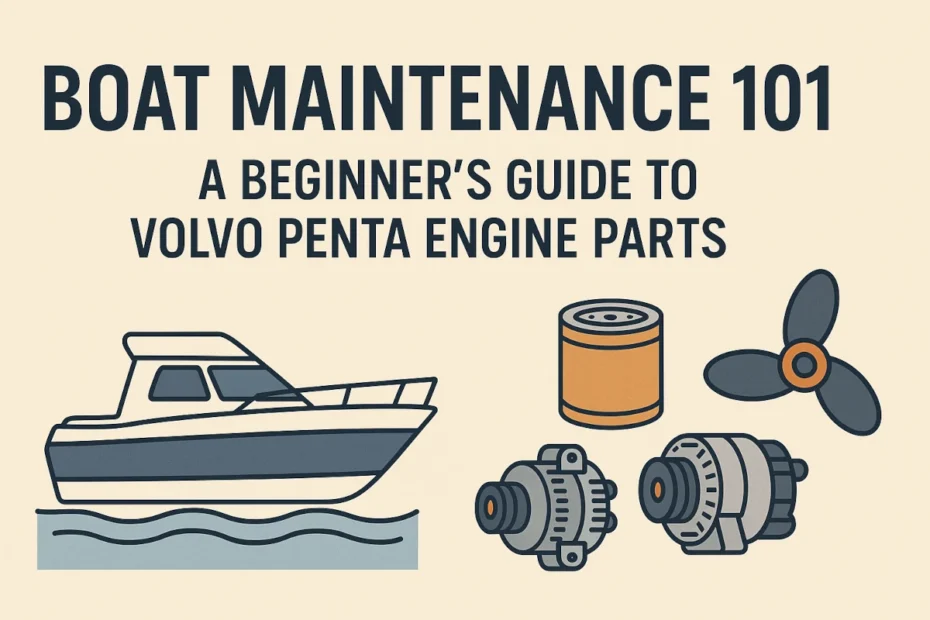Introduction
Importance of Regular Boat Maintenance
Ever gotten stuck in the middle of the sea with an engine failure? Sounds like a nightmare, doesn’t it? Regular boat maintenance isn’t just recommended, it’s essential. Keeping your boat in tip-top shape ensures safe voyages, reliable performance, and longer engine life.
Why Volvo Penta Engines?
Volvo Penta engines are widely trusted for their durability, reliability, and powerful performance. Boat owners worldwide prefer them for their smooth operation and ease of maintenance. But understanding your Volvo Penta engine parts is key to maximising these advantages.
Getting Started with Volvo Penta Engines
Identifying Your Engine Model
Before diving into maintenance, know your engine. Your Volvo Penta engine has an identification tag, typically on the engine block. Familiarise yourself with your model number—it’s your roadmap to finding accurate parts and manuals.
Understanding Basic Engine Components
Volvo Penta engines share common elements like fuel systems, cooling systems, and electrical parts. Knowing these basics makes maintenance and troubleshooting simpler.
Essential Volvo Penta Engine Parts
Fuel System Components
Fuel Filters
Fuel filters ensure your engine runs cleanly by preventing debris and water contamination. Regularly replace these to keep your engine purring smoothly.
Fuel Pumps
Fuel pumps circulate fuel from your tank to the engine. If you notice uneven power or difficulty starting, your fuel pump may need replacing.
Cooling System Components
Water Pumps
Water pumps are crucial for keeping the engine cool. Inspect regularly, and replace when wear or leaks appear to prevent overheating.
Heat Exchangers
Heat exchangers manage your engine’s temperature efficiently. Maintain these parts to avoid severe engine overheating issues.
Lubrication System Components
Oil Filters
Oil filters remove contaminants and protect your engine from internal wear. Replacing them regularly is essential for a healthy engine.
Oil Coolers
Oil coolers help maintain ideal oil temperature, preserving lubrication effectiveness. Regular inspection prevents overheating.
Ignition and Electrical Components
Spark Plugs
Good spark plugs mean reliable engine starts and smooth running. Replace periodically according to manufacturer guidelines.
Alternators and Starters
The alternator charges your battery, while starters crank your engine. Both are vital—regular checks prevent surprise breakdowns at sea.
Routine Maintenance Tips
Daily Checks
Before hitting the water, always perform quick checks on oil levels, coolant, alternator belt, and other belts and visible wear. Catching issues early saves headaches later.
Seasonal Maintenance Tasks
Prepare your engine seasonally. This includes oil changes, replacing filters, and thoroughly checking all belts, hoses, and electrical connections.
Signs of Volvo Penta Engine Problems
Common Symptoms of Engine Issues
Strange noises, excessive smoke, overheating, and loss of power indicate potential problems. Recognising these symptoms early prevents costly repairs.
Troubleshooting Guide
For minor issues like sluggish starting or overheating, first check basics like fuel supply, oil condition, coolant levels, and spark plugs. Often, simple fixes resolve bigger issues.
How to Choose the Right Volvo Penta Parts
OEM vs. Aftermarket Parts
OEM (Original Equipment Manufacturer) parts ensure the best fit and compatibility, while aftermarket parts might save money but occasionally sacrifice quality. Choose wisely, based on reliability versus cost.
When it comes to older marine engines, aftermarket parts often shine brightly due to their exceptional quality and improved availability. Unlike OEM parts, which can sometimes be challenging to source for ageing Volvo Penta engines, aftermarket alternatives frequently offer upgraded materials and innovative designs, tailored specifically to prolong the life of vintage engines. Many aftermarket manufacturers specialise in creating components that outperform original specifications, addressing common weaknesses found in older OEM designs. For boat owners looking to maintain their classic marine engines without breaking the bank or compromising reliability, carefully selected aftermarket parts are often the smartest and most practical choice.
Recognising Genuine Parts
Always buy from reputable sources, e.g. Parts4engines, checking for proper branding, packaging, and authenticity certifications. Genuine Volvo Penta engine parts come clearly labelled and backed by warranties.
Installing and Replacing Volvo Penta Engine Parts
Basic Tools Needed
You don’t need a professional workshop. Basic tools, such as wrenches, screwdrivers, pliers, and socket sets, are sufficient for most DIY tasks.
Safety Tips for DIY Repairs
Always turn off the engine, disconnect the battery, and ensure proper ventilation. Safety first:- especially on watercraft!
Conclusion
Taking care of your boat and its Volvo Penta engine parts is a rewarding experience that prolongs engine life, enhances reliability, and ensures enjoyable, safe adventures on the water. With regular attention and genuine parts, you can avoid those inconvenient and potentially dangerous breakdowns. Happy boating!
